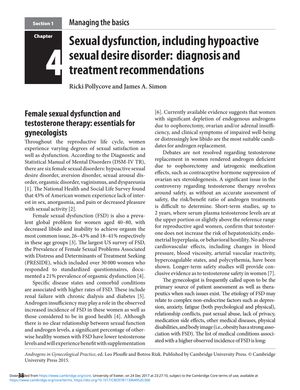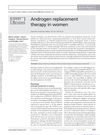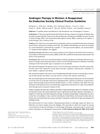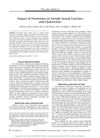Sexual Dysfunction, Including Hypoactive Sexual Desire Disorder: Diagnosis and Treatment Recommendations
July 2015
in “
Cambridge University Press eBooks
”

TLDR Testosterone therapy can improve sexual function in women but long-term safety is unclear.
The document from 2015 examines the prevalence, diagnosis, and treatment of female sexual dysfunction (FSD), including hypoactive sexual desire disorder (HSDD). It reports that 43% of American women experience sexual dissatisfaction, particularly those aged 40-80. Diseases like renal failure and diabetes are associated with higher rates of FSD, and androgen insufficiency may play a role, with testosterone supplementation showing benefits for some women. However, the long-term safety of testosterone therapy is uncertain. The document suggests that gynecologists should assess and treat patients, considering psychological and relationship factors, and use a collaborative care approach. Testosterone or its precursors are considered new treatment options for FSD. A study of 31 premenopausal women with testosterone deficiency found significant improvements in well-being, mood, and sexual function with 10 mg testosterone gel. Another study showed a 50% or higher increase in sexual self-rating scores in 46% of the treatment group using a 10 mg testosterone transdermal cream. Despite no FDA-approved testosterone products for women in the US, some European and Australian products are approved for HSDD in surgically menopausal women. The document also reviews potential long-term side effects of androgen therapy, including skin, metabolic, and cancer risks, but notes that physiologic levels of testosterone therapy have not shown significant adverse effects. Clinical trials summarized in the document indicate that testosterone therapy can improve various aspects of sexual function and may affect lipid profiles, but further long-term studies are needed to assess its efficacy and safety. Contraindications for testosterone therapy include conditions like androgenic alopecia, acne, hirsutism, hyperlipidemia, liver dysfunction, and a history or risk of certain cancers.




